These Recordings have been captured during our Bigfoot Research outings. If the recording is listed on this page we have some reservations about making a call as to what is doing the vocalizing. We are not claiming that all of these are Bigfoot vocals, just that they are currently unidentified and interesting. In most cases we are in very remote locations with restricted disclosure of our location, making human presence unlikely. If you feel that you have heard these sounds before or know via observation what is making these sounds please feel free to use the "Feedback form" at the bottom of this page. The form will forward an email with your comments to us, we will only respond to your input if you ask us to contact you. Thanks.
1. (New) Vocals - These were recorded in East Texas near the Neches River in the early morning hours of October 27th, 2010. A three man team setup a listening post along a hunting lease road where they hung up a recorder which would be retrieved the next morning. Over the next 90 minutes they performed several manual whoops while listening for return vocals before moving to another research location. The vocals in this recording were captured at 1:50AM, about 15 minutes after the research team cleared the area. This includes many vocals covering a span of about 3 minutes, some of the distant howls are definite coyotes. The three close whoop/howls are what we consider to be interesting. There was not a repeat of the close vocals you will hear during the remainder of the night. The spectrograph below represents the span from just before the first close vocal to just after the second. These have a definite human quality to them and humans would be a possible candidate for this, however, no human presence was detected in the area by the team during the time of their visit and no human activity is detectable during the interim from the time the team left and the occurance of the vocals. Both the raw recording and a filtered/shortened (to tone down the local cricket) version can be listened to from the links below.
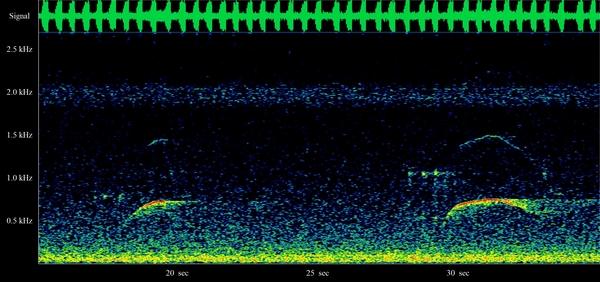
2. Vocals - These were recorded in Central Texas on the Trinity River in the early morning hours of July 11th. There are 10 vocals in all covering just over a minute in duration, these did not occur at any other point either before or after during the night. No call blasting or active investigation was conducted on this night, one of our researchers entered the area placed the audio recorder at 20:30hrs and returned to recover the next day. Possible candidates for this could be Owl or Fox, however, neither seem a good fit based on missing elements such as the typical Owl "Whos" that would normally follow screams of this sort. The spectrograph below represents the first 20 seconds of the raw recording, both the raw recording and a filtered version can be listened to from the links below.
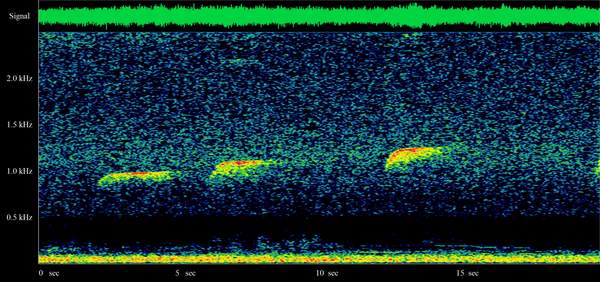
3. Vocals - These were recorded in South Central Louisiana on March 13th, 2010 beginning at 22:51 hours. We deployed recorders off of an ATV trail in the WMA that we have been working for the last several years. The vocals listed below were captured about 30 minutes before we returned to this area to try some call blasting. Below we have provided the original copies of all 3 vocals plus a cleaned version of the one that is shown in the spectro. Our call blasting later in the evening just East of this position did not elicit any vocals like these in response.
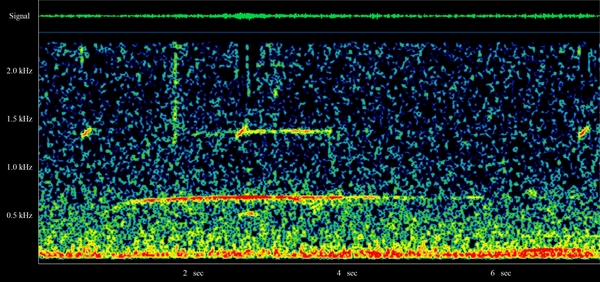
22:51 Vocal comparison with Stevens Pass Recording - It occurred to us that the vocal recorded at 22:51hrs above sounds very similar to recordings made by researchers in Washington state. Go here to read more about the research and followup study on those recordings. Other than the Washington vocal being longer there are some strong similarities between the two vocals. We took one of the Washington recordings and placed it in this file back to back with our recording to demonstrate what we are talking about. Below is a spectrograph showing the 2 vocals in a visual representation.
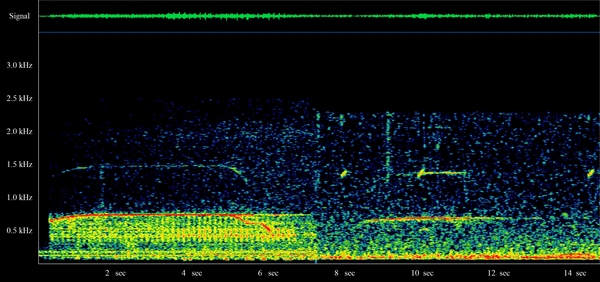
4. Whoops - This was recorded in East Texas in May 2008 on private property. We were camped on the only road in, so its unlikely that humans were responsible as they would have had to pass by us to reach the location, time for this was 2:27AM.
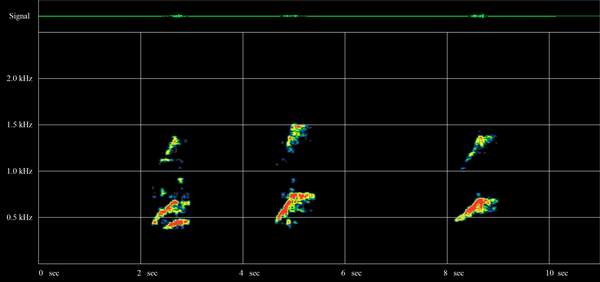
5. Whoops - This is the same sequence as above but was recorded from a second location. This one is probably slightly farther from the source but has less competing bug noise.
6. Louisiana Whoops - These were recorded on the morning of February 1st 2009, in one of our research areas in Louisiana that is known for suspected Sasquatch activity. On this occasion one of our research team members was the only person in the campground. The time was 9:30AM in the morning, he was awoken by what he thought sounded like whoops. He quickly activated his recorder and captured this sound file. There are three whoops with the third one being the best, these are very similar to the two recordings captured in East Texas listed above, we have provided a spectrograph comparision of the two recordings below.
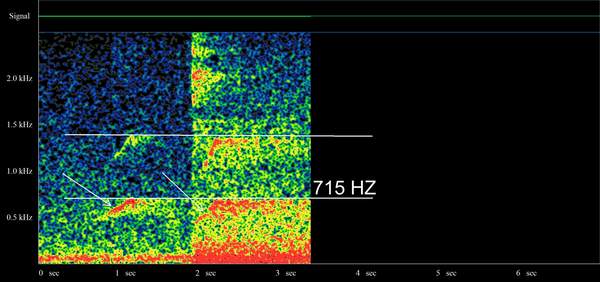
In the spectrograph above, one of the East Texas whoops recorded on 5-4-08 is on the left and one of the Louisiana whoops is shown on the right in a side by side comparison. The spectrograph reveals that the two recordings are remarkably similar in pitch, quality and rate of pitch increase. This is highly suggestive, in our opinion, that these vocalizations were made by a wild living creature indigenous to the wilderness areas of Texas and Louisiana. Despite their obvious humanlike quality, and compact spectra, which is typical of human vocalizations, these whooping sounds may very well be the actual sounds made by sasquatch or bigfoot-like creatures. Click the link below to listen to the 2 whoops in the spectrograph played back to back.
7. Texas/Louisiana Whoops - Here are the 2 whoop recordings looped together in a single audio file, the Texas whoop is first followed by the Louisiana whoop.
8. Unknown Vocals - These were recorded in the Sam Houston National Forest. Fox, Coyote or ?
9. Unknown Vocal - This was recorded on private property in an area where other activity of interest is ongoing, we haven't released it before due to our thinking it might be a horn or some other human made sound. Most people's reaction is "what the heck". There is an equal chance it is a vocalization from the local wildlife and if so is currently unidentified, if someone out there thinks they know what it is feel free to contact us.
10. Unknown Vocals - This was recorded on the Trinity River in December of 2009. There are 3 vocals, short howls or elongated whoops. We lean to Fox for these but are not sure if this is correct. The was edited to remove people talking in close proximity to the recording unit. If someone out there thinks they know what it is feel free to contact us.
11. Unknown Vocal - This was Recorded in SE Louisiana in March 2007, the current cast of possibles for this one could include Fox, Owl or .......? The spectrograph below shows first the scream recorded then the vocal image of a human female saprano and it is quite close, but we know that there were no female opera singers at this location on this night. This vocalization was featured on the popular History Channel show MonsterQuest in the Swamp Stalker Episode where Rick Noll is shown call blasting the cleaned up version of this vocal. Click here to view this episode.
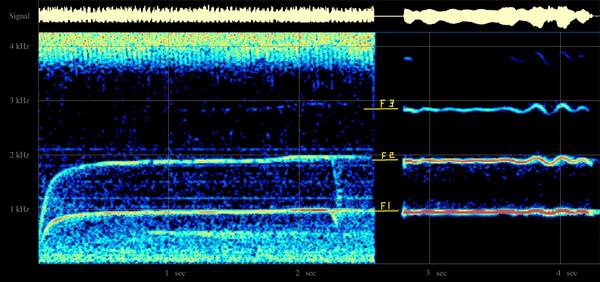
12. Unknown Vocal - This was Recorded in East Texas in May 2008, this one is probably canid in origin but if so demonstrates some impressive abilities to mimic what it hears. The first vocal is our call blast followed bye the return vocals which were recorded by a digital recorder that was placed far from our blast point to record vocal responses such as these. You can see the visual representation in the spectro capture below, interesting how the resonant frequencies seem to line up. This vocal was featured on the popular History Channel show MonsterQuest in the Hillbilly Beast episode. Dr. Joe Fox has been working on several of our unidentified recordings and used this one on the show during their call blasting in Kentuckty. We have this episode linked on our YouTube Videos page which you can view by going here.
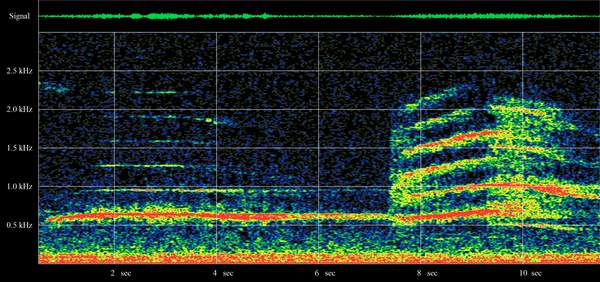
13. Unknown Vocals - This was recorded in Eastern Oklahoma on January 23rd, 2010 at
01:28 hours. We were camped in a public camp ground, from there we traveled roads running into remote valleys and river bottoms in
this part of Eastern Oklahoma. We call blasted for several hours and left recorders behind to record over night, we had just left
the location of this recording about 5 minutes before these vocals were captured, you will hear a gust of wind followed at 7 seconds
into the recording by a very distant faint "whoop" and then 9 seconds later you will hear a much closer "yahhh" type of scream. The
whoop may require head phones to hear.
14. Unknown Vocal - Here is another oddity that was recorded in July 2006, we had just call blasted and it set off a distant pack of coyotes. However we had not, prior to nor since, heard the squalling sound heard in this that you will hear mixed in with the coyotes. Does anyone out there know or have definitively heard coyotes do this? If so, feel free to drop us a note about your experience in the feedback form.
15. Unknown Vocal - This was recorded in August 2006 and has several vocals in it, the barks and the second vocal are canid in origin but what is the first vocal? Owl?
16. Unknown Vocal - This was recorded in May 2007 and has several vocals in it, there are some coyotes in this but we are mostly concerned about the first vocal. This was a response to the Ohio Howl that was blasted just before.
17. Unknown Vocals - While researching on private property in the early morning hours of 2-7-09 well after the team had returned to base camp, we recorded some howls starting at 04:24hrs, 9 in all, some of which you can listen to in the links below. We're not sure what it was, it doesn't sound the same as the coyotes that it set off which sound higher pitched and smaller, listen below and decide for yourself. All vocals sounded just like the 3 that we have provided so if this was canid it did not demonstrate the common pitch changes or yodeling that most canids would perform. It also continued vocalizing well after the coyotes had lost interest, the 9 vocals covered a time of about 15 minutes. The recorder that captured these continued to run until after 7AM with no further vocals of this type being found.